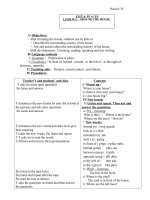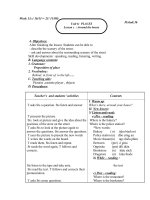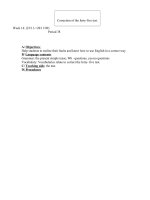Bài giảng tiếng Anh - Phần 4 pptx
Bạn đang xem bản rút gọn của tài liệu. Xem và tải ngay bản đầy đủ của tài liệu tại đây (134.5 KB, 5 trang )
Week 15 (30/11->5/12/09) Period: 41
A. Objectives:
After finishing the lesson. Students can be able to describe the scenery of the quarter.
Skill developments: speaking, reading, listening, writing.
B. Language contents:
1. Grammar:
Indefinite a/an
There is…………….; there are………………
2. Vocabulary:
Quite, clinic, market, zoo, supermarket, noisy …
C. Teaching aids:
Pictures ,cassette player , objects
D. Procedures:
Teacher’s and students’ activities Contents
T asks Sts some questions
Sts answer them
T explains how to do part 2
T asks Sts to read the sentences about Ba’s
house and take note.
T guides sts to write the sentences.
Then T asks Sts to write sentences about Chi’s
house.
Sts read the answers in front of class and
write the sentences on the board
T follows and corrects their faults.
Sts write in their books.
T explains the requirement of the exercise.
Sts look at the table in part 3 and guess where
Minh, Tuan, Nga live.
After that Sts listen to the tape two times
Sts change and correct the answers.
I. Warm up:
Is your house in the country or in the city?
What’s there, around your house?
Is there a yard in front of your house?
Are there any trees behind your house?
II. New lesson:
2/ Read about Ba. Then write sentences
about Chi’s house
Chi lives in a house in the country.
Near her house. There aren’t any stores.
It‘s very noisy.
3/ Listen and check. Complete this table in
your exercise book.
Name City Town country Apartment
house
Minh
√ × × √ ×
Tuan
× √ × × √
1
Unit7: YOUR HOUSE
Lesson B: Town or Country?
Sts listen to the tape again and complete the
table.
T follows and gives the correct answers
T reminds the yes /no question
Sts follow and take note.
T asks Sts some questions.
T follows and comments.
Sts learn by heart the lesson.
Sts prepare the new lesson and the exercise
Nga
√ × × × √
III/. Consolidation ( remember)
Do you live in city?
No, I live in the country.
Does he live in town?
No, He lives in the country
Aren’t = are + not
* Exercise :Answer the questions:
1. Where is your house?
2. Where do you live?
3. Is your house in the country?
4. Do you live in a big house?
IV. Homework :
Learning by heart the lesson
Unit 7: (cont) Lesson C : On the move
Exercise 3,4 (page ,69)
Period 42,43
A. Objectives:
After finishing the lesson. Students can be able to:
- - Talk about the transportations.
- Ask and answer the transportations
- Talk about habitual actions.
Skill developments : speaking, reading, listening, writing.
B. Language contents:
1. Grammar:
Adverb phrase
2. Vocabulary: Bike, motorbike, bus, car…
C. Teaching aids:
Pictures ,cassette player , objects
D. Procedures:
2
Unit 7: YOUR HOUSE
Lesson C: On the move
Teacher’s and students’ activities Contents
T asks Sts some questions
Sts listen and answer the questions
T comments.
T introduces the situation of the lesson
T asks Sts some questions
Sts look at the pictures and answer the
questions.
T reads the words , Sts listen and repeat
Sts read them in front of class,
T follows and corrects.
Sts listen to the tape
Before reading the sentences. T explains
how to answer the questions about these
people
T makes an example
Sts read the sentences. T follows and
corrects their faults
Sts practice asking and answering in pairs.
Sts practice in pairs in front of class.
T follows and corrects their faults
T asks Sts some questions.
Sts listen and answer them
.
T asks Sts some questions
Sts look at the pictures and answer
T introduces the situation and uses the
pictures to introduce the new words.
T writes the words on the board.
T reads them, Sts listen and repeat.
Sts read the words again, T follows and
corrects
I. Warm up:
How are you today?
Where do you live?
How far is it from your house to school?
How do you go to school?
II. New lesson:
1/ Listen. How do you go to school?
a. Pre- listening
Who are they?
How do they go to school?
Does she go to school by bike?
* New words:
Bike (n) = bicycle (n) xe đạp
Motorbike (n) xe mô tô
Bus (n) xe buýt
Car (n) xe ô tô
b. While –listening :
The sentences
Ex: How does Lien go to school?
->She goes by bike
Now ask and answer the questions about
these people.
How does …… go to school?
She / He goes to school by…….
She / He walks to school
c. Post-listening:
How far is it from your house to school?
How do you go to school?
Do you go to school by bus?
2/ Listen :
a. Pre- listening
Who is he? she?
How does she/ he travel to work?
* New words:
Travel (n) đi lại,đi du lịch.
Plane (n) máy bay.
Train (n) xe lửa
b. While – listening :
3
Sts listen to the tape
T gives an example and guides sts to do the
exercise.
Sts look at the pictures and practice asking
and answering the questions in pairs.
Sts practice in front of class.
T follows and corrects their faults.
T asks Sts some questions.
Sts listen and answer.
Teacher comments
T explains how to do exercise and gives an
example
T asks Sts to remind some transportations
Sts listen to the tape and take note.
Sts listen to the tape again and write short
answers
Sts change the answers with their friends
Sts write the short answers on the board.
T T follows and corrects.
Sts practice asking and answering
T follows and corrects their faults
T introduces the situation of the lesson
T asks Sts some questions
Sts look at the pictures and answer
T reads the words , Sts listen and repeat
Sts read them, T follows and corrects
Sts listen to the tape
Before reading the text. T asks Sts to read
the answers
Sts read the text in silent
Sts read the text. T follows and corrects their
pronunciation.
*Practice with a partner:
Ex: How does Mr Ba travel to work?
He travels by motorbike.
Picture b: How does Miss Hoa travel to
work?
->She walks to school
Picture c: How does Mr Kim travel to
work?
->He travels by train
Picture d : How does Mrs Ba travel to
work?
->He travels by car
c. Post-listening
How do you go to school?
Do you go to school by bike or by bus?
3/ Listen and write short answers in
your exercise book.
Example:
How do they travel?
By bus
a. How does Ba travel?-> By motorbike
b. By plane
c. By bus
d. By bike
e. By bus
f. By car
g. By train
h. By walks (on foot)
4/ Listen and read. Then ask and
answer the questions.
a. Pre- reading
Who is he?
Where does he go?
How does he go to school?
* New words:
Leave (v) rời khỏi
Lunch (n) bửa ăn trưa
b. While –reading :
The text
a. What time does Hoang get up?
-> He gets up at half past five.
b > He goes to school at half past six.
c > No, he doesn’t .
4
Sts practice asking and answering. Then
writing them on the board
T follows and corrects their faults.
T asks Sts some questions.
Sts listen and answer them
T follows and corrects their faults.
T asks Sts to match the subjects with the
verbs and explains them.
Sts practice asking and answering the
questions.
Teacher follows and corrects their faults.
T asks Sts to complete the sentences with
the correct form of the verb.
Sts do them. T follows and corrects their
faults
Students prepare the new lesson and do
exercise
Sts learn by heart the lesson
d. -> Yes, he does.
e > Classes start at seven.
f > They end at half past eleven.
c. Post-reading:
What time do you go to school?
Do you go to school by bicycle?
What time do classes start?
III/. Consolidation ( remember)
I get
You leave
We start
They end
He / She + gets/ leaves/ starts/ ends
How do you go / travel…?
I go / travel by……….
How does he go / travel?
He goes/ travels by……
* Exercise :
Complete the sentences with the correct
form of the verb:
a. My sister……to work by bus (go)
b They……to work by bus (travel)
c Lan……to school (walk)
d How . ……Minh……to school ?(go)
IV. Homework :
Unit 8: Out and About Lesson A: what
are you doing?
Exercise 2,3,4 ( page 70,71 )
* Experience:
5
Signature (28/11/09)
Trương Ngọc Điệp









